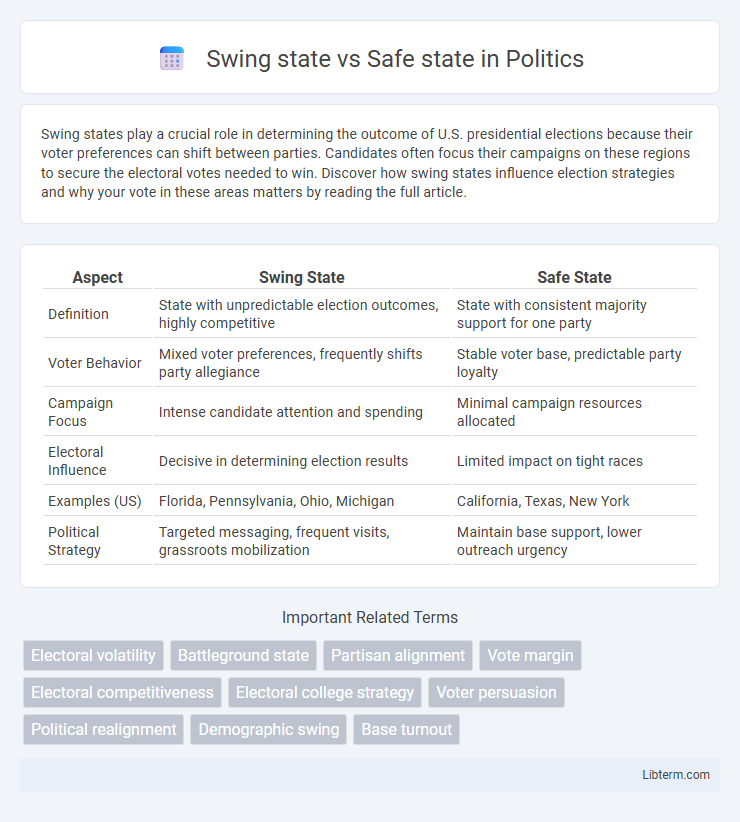Swing states play a crucial role in determining the outcome of U.S. presidential elections because their voter preferences can shift between parties. Candidates often focus their campaigns on these regions to secure the electoral votes needed to win. Discover how swing states influence election strategies and why your vote in these areas matters by reading the full article.
Table of Comparison
| Aspect | Swing State | Safe State |
|---|---|---|
| Definition | State with unpredictable election outcomes, highly competitive | State with consistent majority support for one party |
| Voter Behavior | Mixed voter preferences, frequently shifts party allegiance | Stable voter base, predictable party loyalty |
| Campaign Focus | Intense candidate attention and spending | Minimal campaign resources allocated |
| Electoral Influence | Decisive in determining election results | Limited impact on tight races |
| Examples (US) | Florida, Pennsylvania, Ohio, Michigan | California, Texas, New York |
| Political Strategy | Targeted messaging, frequent visits, grassroots mobilization | Maintain base support, lower outreach urgency |
Understanding Swing States and Safe States
Swing states, also known as battleground states, are regions where election outcomes are highly competitive and can change between parties, significantly influencing the overall result. Safe states consistently support a particular political party, providing predictable electoral outcomes that rarely shift between elections. Understanding the distinction between swing and safe states is critical for campaign strategies, as swing states receive more attention, funding, and voter mobilization efforts.
Key Characteristics of Swing States
Swing states, also known as battleground states, exhibit highly competitive electoral dynamics with no consistent party dominance, making them critical in determining U.S. presidential election outcomes. Key characteristics include fluctuating voter preferences, closely split party registrations, and significant demographic diversity that influences voting patterns. Campaign strategies heavily target swing states due to their potential to swing either Democratic or Republican, unlike safe states where electoral outcomes are largely predictable.
Defining Features of Safe States
Safe states are characterized by consistent voting patterns favoring a particular political party, leading to predictable election outcomes. These states typically have a strong historical alignment, demographic homogeneity, and entrenched party loyalty, minimizing electoral competition. The stability of safe states simplifies campaign strategies by allowing candidates to allocate resources elsewhere.
Historical Shifts in Swing and Safe States
Historical shifts in swing and safe states often reflect changes in demographic patterns, economic conditions, and political realignments. States like Florida and Ohio have frequently transitioned between swing and safe status due to evolving voter preferences and migration trends, influencing national election outcomes. The Southern United States, once a Democratic stronghold, became a Republican safe zone over recent decades, highlighting significant partisan shifts and regional realignments.
The Role of Swing States in Presidential Elections
Swing states, also known as battleground states, play a pivotal role in U.S. presidential elections by determining the overall electoral college outcome due to their unpredictable voting patterns. Candidates allocate significant campaign resources, including time, advertising, and visits, to these states to sway undecided voters and secure crucial electoral votes. In contrast, safe states consistently vote for the same party, requiring less attention and allowing campaigns to concentrate efforts on swing states to maximize electoral advantage.
Why Candidates Focus on Swing States
Candidates focus on swing states because these states have unpredictable voting outcomes that can decide the overall election result. Swing states receive more campaign visits, advertising, and policy promises as candidates aim to sway undecided or marginal voters. Safe states, with consistent party loyalty, receive less attention since their outcomes are considered predictable and unlikely to change the election's balance.
Electoral Impact of Safe States
Safe states have a predictable voting pattern, significantly reducing campaign resources spent on these areas while allowing candidates to focus on swing states with uncertain outcomes. The electoral impact of safe states lies in their reliable allocation of electoral votes, providing a foundational base that strengthens a candidate's overall strategy. This stability influences campaign strategies by prioritizing battleground states without neglecting the consistent support garnered from safe states.
Recent Trends in Battleground States
Recent trends in battleground states like Arizona, Georgia, and Wisconsin show increased voter turnout and demographic shifts favoring competitive races between Democrats and Republicans. Swing states exhibit fluctuating party support influenced by factors such as suburban growth, racial diversity, and economic concerns, while safe states remain reliably aligned with one party due to entrenched voting patterns. Data from the 2020 and 2022 elections highlights the narrowing margins in traditional swing states, emphasizing their decisive role in national election outcomes.
Voter Behavior: Swing vs. Safe States
Voter behavior in swing states is characterized by higher engagement and strategic voting due to uncertain election outcomes, contrasting with safe states where voter turnout tends to be lower because the result is often seen as predictable. Swing state voters often experience intense campaign efforts, including targeted advertisements and visits from candidates, which influence voter preferences and increase political awareness. Safe state voters may exhibit complacency or consistent party loyalty, reducing the variability in election results within those regions.
Future Outlook: Evolving Electoral Maps
Swing states are expected to shift as demographic changes and urbanization alter voter profiles, influencing future electoral competitiveness. Safe states remain politically stable due to entrenched party loyalties and predictable voting patterns, but emerging social trends could gradually redefine their status. Analysts predict that evolving population dynamics and strategic campaign investments will reshape electoral maps, increasing the importance of previously overlooked regions.
Swing state Infographic

 libterm.com
libterm.com